Bringing Nature’s Beauty Indoors: Flowers Just for Cutting…
~ A bouquet of dahlia and calendula brightens my windowsill ~
One of the great pleasures of successful flower gardening is, of course, the access to seasonal, fresh cut flowers for the dinner table, desk and elsewhere in the home. I also really enjoy bringing an exotic bouquet to my host or hostess when I am invited to a dinner party, or to a friend as a surprise. Earlier this summer, in my posts about designing a potager and companion planting in the vegetable garden, I mentioned the horticultural benefits of growing flowers in a kitchen garden. But as an artist, I have many reasons, way beyond the practical, for a cutting garden. Flowers are a great inspiration; the extraordinary colors and amazing geometric forms can shift a mood, spark a creative impulse, or simply add a touch of beauty to the day. Know someone with a bland office cubicle, or sterile waiting room? Imagine what a few colorful zinnias would do to change the atmosphere. It’s amazing really. That old 1960’s slogan “Flower Power” couldn’t be more accurate.
Zinnia and Dahlia ~ copyright 2009 ~ Tim Geiss
Growing annuals for cutting can be as simple as sowing seed or planting six packs in the vegetable garden in spring. I grow my cutting garden in well drained soil enriched with compost, and I fertilize with Neptune’s Harvest or whatever fish emulsion I have on hand. My own cutting garden varies in size each year depending upon my available time, space and budget. This year, I purchased common annuals in six packs from Walker Farm and a few of the specialty annuals they are known for. I chose dahlia, zinnia, cleome, cosmos, verbena bonariensis, specialty calendula, (French marigold), and moluccella laevis, (Bells of Ireland), among others. I also grow some perennials in and around my vegetable garden, including early bloomers like bulbs and peonies and late-season favorites such as coreopsis tripteris, physostegia virginiana, liatris ‘Kobold’, veronica ‘Goodness grows’, rudbeckia, echinacea and solidago, (golden rod), to name but a few. Native goldenrod is a great addition to flower arrangements. Sadly, although solidago is a prized perennial in much of Europe, this native flower is shunned by many North American gardeners who mistakenly believe it to be a cause of hay fever, (ambrosia artmisiifolia, or common ragweed, is usually the culprit). I always buy my annuals locally in spring. But you can also find bulbs and plants through online retailers, including my two of my favorite sources for summer bulbs, Swan Island Dahlias and Brent and Becky’s Bulbs.
Combining perennials and annuals in casual arrangements is one of my favorite ways to bring the garden indoors, (see photo below). I like to play with contrasting colors like orangey-yellow and purple, or bright blue and reddish-orange to enliven my kitchen table. When creating bouquets for the bedroom or bath, I often soften the mood a bit, and combine flowers in more complimentary hues; using tones of blue and green, or shades of lavender and rose. Whatever I create with flowers from my garden, the arrangements have a way of making the whole house look brighter.
In order to get the most life from cut flower arrangements, I try to harvest the blooms in early morning, before the heat of the day, or in the cool of the evening after the sun has set. I choose flowers with swollen buds or petals just opening. With sharp scissors, I cut the stems long and at a slight angle. Immediately, I place them in a bucket of lukewarm water kept in the shade while I make my other selections. Certain flowers, such as poppies, will need to have their stalks seared with a match in order to seal the stem. And most early bulbs, such as daffodils, prefer cool vase water. Cut flowers will stay fresh longer when you add a couple of tablespoons of lemon juice, about a tablespoon of sugar and 1/2 teaspoon of bleach to each quart of vase-water. Changing the vase-water every couple of days will extend the life of your bouquet and keep the flowers looking fresh longer. Bacteria is responsible for that nasty flower-water slime and smell when you forget to change the water for a week. I try to avoid that olfactory experience at all costs!
Annual Cosmos ‘Candy Stripe’, Calendula ‘Pacific Beauty Mix’, Rudbeckia hirta ‘Becky Mixed’ here with perennial Veronica ‘Goodness Grows, Liatris ‘Kobold’, Echinacea purpurea and Solidago Canadensis Gunmetal Glazed Pitcher by artist Aletha Soule
Rudbeckia hirta ‘Goldilocks’ produces 18″-24″ stems with 4″ double orange blossoms… perfect for late summer bouquets
To add a little something extra to my bouquets, I often add ornamental grasses, (such as miscanthus), foliage plants, (including ferns and perennial plant leaves), vines, (such as bittersweet), and branches from trees and shrubs. Shrubs with darker foliage, including physocarpus ‘Diablo’ or ‘Summer Wine’, and weigela ‘Java Red’, among the many choices, add a nice contrast to floral arrangements in complimentary hues. When adding woody plants like these, as well as flowering hydrangea and lilac to an arrangement, it ‘s important to “smash” the woody stems with a mallet in order for the cut branch to absorb water, (see center photo below). Â In addition to beautiful color and texture, woody plants add structure to a vase, and can help support both delicate flowers and heavy blooms, especially those with a tendency to flop.
White cleome, zebra grass and weigela florida ‘Java Red’ foliage in a vase by  Aletha Soule
Flowers harvested from shrubs with woody stems must be ‘smashed’ as shown, to help them absorb water
~ A beautiful raku vase by Vermont artist Richard Foye ~
And from the garden: Ninebark, (Physocarpus), ‘Diablo’, False indigo foliage, (Baptisia), Foxglove, (Digitalis davisiana), Queen Anne’s Lace, (Anthriscus sylvestris), and Bells of Ireland, (Moluccella laevis)
~ Hydrangea paniculata ‘Limelight’ in a small vase by artist Aletha Soule ~
When it comes to choosing vases, I am a big believer in experimentation. Although I have a nice collection of vases from Vermont artisan Richard Foye and California’s Aletha Soule, I do not limit myself to traditional vessels for holding fresh flowers. I am just as likely to stick a bouquet into a rusty tin can when the orange-brown contrast strikes my fancy. Old mason jars, drinking glasses, perfume and liquor bottles, beach buckets, cookie tins, soda bottles and milk cartons have all served as vases in my household. In fact, pretty much anything that holds water is fair game. Floating flowers in a shallow bowl with candles makes for a memorable center piece at a dinner party, and the low display draws attention to the structure of larger flowers such as dahlia and sunflower. I also like the look of one spectacular blossom filling the top of a thick glass, as photographed by artist Tim Geiss below.
As the seasons change, I like to bring autumn leaves and bare branches into the house for my larger urns. And early autumn vegetables, such as kale and cabbage, make dramatic additions to flower arrangements as well. When November and December come ’round, I will bring in winterberry, (Ilex verticillata), and dried grasses from the garden by the armful. Do you have any favorite additions to your floral arrangements? I will be featuring more articles like this one in the future, but for now, please feel free to share your ideas and add comments for others here on the forum. In a world filled with chaos, stress, uncertainty and pressure, we could all use a little beauty to brighten our day. Sometimes, even a milk carton of roadside daisies will do!
~ Freshly cut Zinnia, copyright 2009, Tim Geiss ~
***
~ Special thanks to Tim Geiss for his beautiful flower photographs as noted ~
~ Article and other photos copyright 2009 Michaela at The Gardener’s Eden ~
***
3 Replies to “Bringing Nature’s Beauty Indoors: Flowers Just for Cutting…”
Comments are closed.
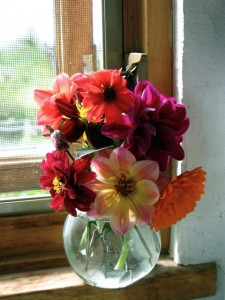
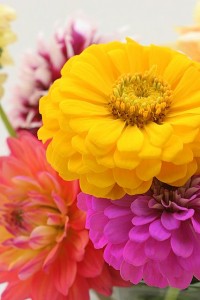
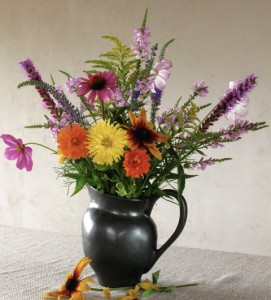
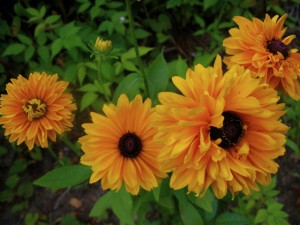
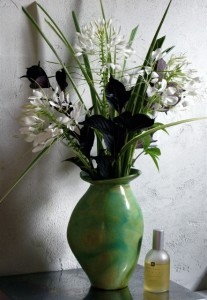
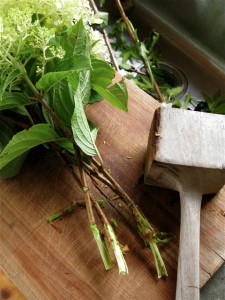
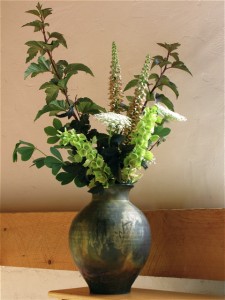
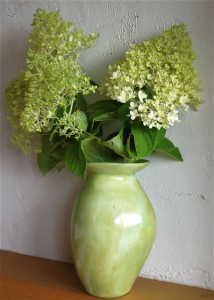
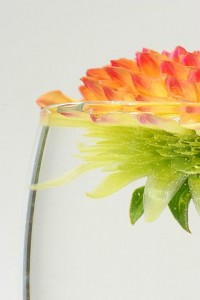
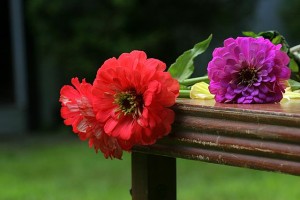
lovely lovely arrangements! beautiful vases!
such a nice article! me, who has ADD of the computer reading..read the whole thing! nice! You are a wonder!xoxo
How nice of you to say, Lulu. I am flattered to have held your attention for so long. Hope you will be back soon… I think you deserve some nice State Fair Zinnias ! :)